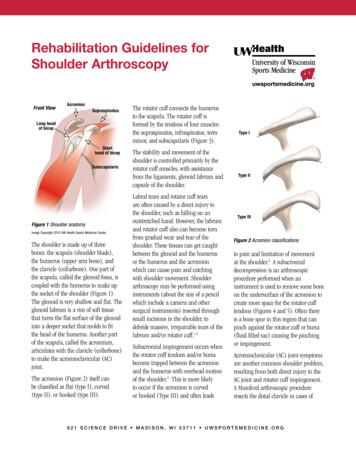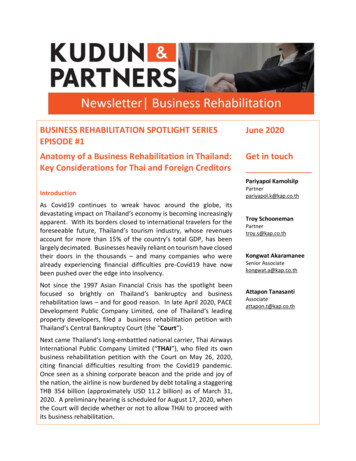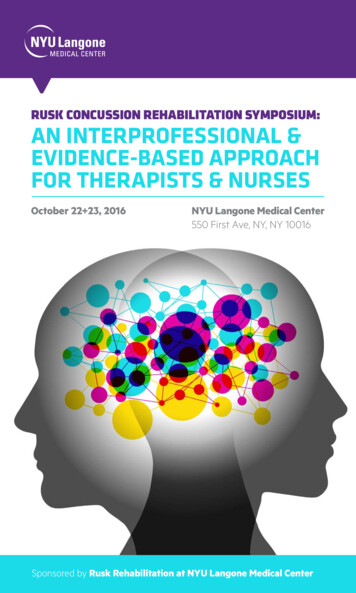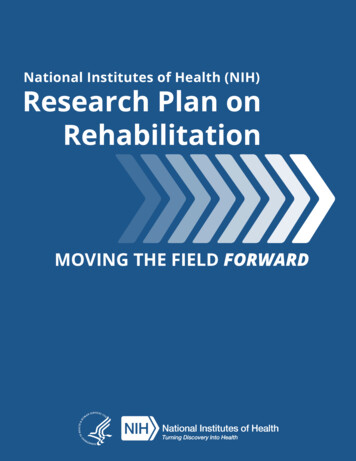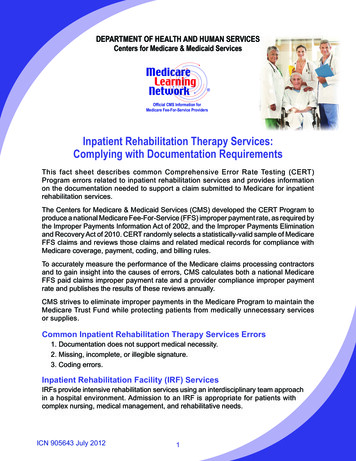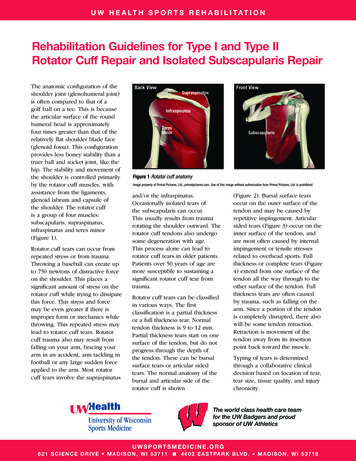
Transcription
U W H E A LT H S P O R T S R E H A B I L I T A T I O NRehabilitation Guidelines for Type I and Type IIRotator Cuff Repair and Isolated Subscapularis RepairThe anatomic configuration of theshoulder joint (glenohumeral joint)is often compared to that of agolf ball on a tee. This is becausethe articular surface of the roundhumeral head is approximatelyfour times greater than that of therelatively flat shoulder blade face(glenoid fossa). This configurationprovides less boney stability than atruer ball and socket joint, like thehip. The stability and movement ofthe shoulder is controlled primarilyby the rotator cuff muscles, withassistance from the ligaments,glenoid labrum and capsule ofthe shoulder. The rotator cuffis a group of four muscles:subscapularis, supraspinatus,infraspinatus and teres minor(Figure 1).Rotator cuff tears can occur fromrepeated stress or from trauma.Throwing a baseball can create upto 750 newtons of distractive forceon the shoulder. This places asignificant amount of stress on therotator cuff while trying to dissipatethis force. This stress and forcemay be even greater if there isimproper form or mechanics whilethrowing. This repeated stress maylead to rotator cuff tears. Rotatorcuff trauma also may result fromfalling on your arm, bracing yourarm in an accident, arm tackling infootball or any large sudden forceapplied to the arm. Most rotatorcuff tears involve the supraspinatusBack ViewFront risFigure 1 Rotator cuff anatomyImage property of Primal Pictures, Ltd., primalpictures.com. Use of this image without authorization from Primal Pictures, Ltd. is prohibited.and/or the infraspinatus.Occasionally isolated tears ofthe subscapularis can occur.This usually results from traumarotating the shoulder outward. Therotator cuff tendons also undergosome degeneration with age.This process alone can lead torotator cuff tears in older patients.Patients over 50 years of age aremore susceptible to sustaining asignificant rotator cuff tear fromtrauma.Rotator cuff tears can be classifiedin various ways. The firstclassification is a partial thicknessor a full thickness tear. Normaltendon thickness is 9 to 12 mm.Partial thickness tears start on onesurface of the tendon, but do notprogress through the depth ofthe tendon. These can be bursalsurface tears or articular sidedtears. The normal anatomy of thebursal and articular side of therotator cuff is shown(Figure 2). Bursal surface tearsoccur on the outer surface of thetendon and may be caused byrepetitive impingement. Articularsided tears (Figure 3) occur on theinner surface of the tendon, andare most often caused by internalimpingement or tensile stressesrelated to overhead sports. Fullthickness or complete tears (Figure4) extend from one surface of thetendon all the way through to theother surface of the tendon. Fullthickness tears are often causedby trauma, such as falling on thearm. Since a portion of the tendonis completely disrupted, there alsowill be some tendon retraction.Retraction is movement of thetendon away from its insertionpoint back toward the muscle.Typing of tears is determinedthrough a collaborative clinicaldecision based on location of tear,tear size, tissue quality, and injurychronicity.The world class health care teamfor the UW Badgers and proudsponsor of UW AthleticsUWSPORTSMEDICINE.ORG621 SCIENCE DRIVE MADISON, WI 53711 4 6 0 2 E A S T PA R K B LV D . M A D I S O N , W I 5 3 7 1 8
Rehabilitation Guidelines for Rotator Cuff Repair and Isolated Subscapularis RepairAFigure 3 Coronal MRI image of an articularsurface tear of the supraspinatus. Note thetop black line has maintained continuity butthe undersurface black line is disrupted.Figure 4 Coronal MRI image of a fullthickness tear of the supraspinatus. Note thewhite fluid present where the dark tendonshould be.BCFigure 5 Rotator cuff repair technique using anchors and sutures. The tear (A) is approximated.Then suture anchors are placed on both sides of the tear (B and C). Finally the tendon isapproximated back to the bone with various suture patterns to decrease focal stress.Prior to bringing the tendon back toits insertion, the edges of the tearmay need to be brought together,referred to as side-to-side repairor convergence (Figure 5). Not allrotator cuff tears are repairable.A tear may be unrepairable if thetear is too large, there is too muchretraction, or the tissue quality istoo poor. The degree of success fortears that are repaired is related tovarious factors, including tear size,the number of tendons involved,patient age, associated injuries andpost-operative rehabilitation.Surgical repair of a rotator cufftear can be done arthroscopicallyor with a mini-open procedure. Areview published in The Journal ofBone and Joint Surgery stated thatequally successful outcomes can beattained from either technique. Theprimary goal of a rotator cuff repairis to restore the normal anatomyby approximating the rotatorcuff tendon back to its normalattachment site on the greatertuberosity of the humerus. This isdone by passing sutures through thetendon and then tying the tendondown to suture anchors that havebeen placed in the humerus.Rehabilitation is vital to regainingmotion, strength and function ofthe shoulder after surgery. Initiallypatients will use a sling to protectthe repair site and allow healingof the tendon back to the bone.During this time, passive motionexercises are started to preventthe shoulder from getting stiff andlosing mobility. The rehabilitationprogram will gradually progressto more strengthening and controltype exercises. The rehabilitationguidelines will vary depending onthe size of the tear, quality of thetissue, healing potential and surgicaltechnique, as well as other patientfactors including age, activity leveland pre-and post-operative stiffness.2UWSPORTSMEDICINE.ORG621 SCIENCE DRIVE MADISON, WI 53711 The rehabilitation guidelines forType I and Type II tears of thesupraspinatus or infraspinatus andisolated subscapularis tears arepresented below in a criterionbased progression. General timeframes are given for reference tothe average, but individual patientswill progress at different ratesdepending on their age, associatedinjuries, pre-injury health status,rehabilitation compliance, injuryseverity and goals.4 6 0 2 E A S T PA R K B LV D . M A D I S O N , W I 5 3 7 1 8
Rehabilitation Guidelines for Rotator Cuff Repair Type ITYPE I TEARSPHASE I (Surgery to 2 weeks after surgery)3Appointments Rehabilitation appointments begin 5-8 days after surgeryRehabilitation Goals Patient education on pathology, procedure, rehabilitation expectations and expected timeframe for return to function, precautions Normalize scapular positioning and mobility Reduce pain and swelling in the post-surgical shoulder Maintain active range of motion (AROM) of the elbow, wrist and neck Minimize loads placed over healing repairPrecautions Suggested PatientEducation Explain surgical procedure Importance of tissue healing to maximize functional outcomes Discuss modification of activities of daily living (ADLs) in order to follow post-operativeprecautions Absence of pain does not correlate with lack of stress on the repairSuggested TherapeuticExercise Elbow, wrist and neck AROM Ball squeezes Passive range of motion (PROM) for forward elevation in the plane of the scapula withexercises demonstrated to have 15% EMG activity level. *See appendix for pictures anddescriptions Supine PROM Forward bow Towel press-up (progressing hands apart) Scapular protraction with ball on table Towel slide PROM for external rotation (ER) in 20 of abduction with 15% EMG activity level Supine PROM Supine active assisted ER with caneCardiovascular Fitness Walking and/or stationary bike with sling on No treadmill Avoid running and jumping due to the repetitive traction forces that can occur at landingProgression Criteria At least 14 days post operative Passive forward elevation 60-90 Passive ER to 20 at 20 of abductionUse sling continuously except while doing therapyNo AROMNo lifting or supporting body weight with handsRelative rest to reduce inflammationUWSPORTSMEDICINE.ORG621 SCIENCE DRIVE MADISON, WI 53711 4 6 0 2 E A S T PA R K B LV D . M A D I S O N , W I 5 3 7 1 8
Rehabilitation Guidelines for Rotator Cuff Repair Type IPHASE II (begin after meeting Phase I criteria, usually post-op weeks 2-4)4Appointments If PROM deficit is present with pain as primary barrier appointments should be 1 time perweek until pain well controlled If PROM deficit is present with stiffness as primary barrier appointments should be 2 timesper week with home exercise program (HEP) performed at least 2-3 times per day dayRehabilitation Goals Progression of elevation in scapular plane and ER in 20-30 of abduction Correct postural dysfunctionsPrecautions Sling utilization will be determined by communication between physician and physicaltherapist. Typical sling use ranges from 4-8 weeks depending on surgical procedure,tissue quality, healing potential and stiffness. No active abduction ROM for 8 weeks to protect repair and no external resistance toabduction and supraspinatus for 12 weeks.Suggested TherapeuticExercise Progress forward elevation and passive ER using only exercise demonstrated to have 15%EMG activity level. *See appendix for pictures and descriptions Supported side lying shoulder flexion Supine forward elevation with elastic band resistance from 90 Small circle (20 cm) pendulums Scapular strengthening Sternal lift Modified shoulder dump Grade I and II joint mobilizations for pain relief as needed at all shoulder girdle jointsGH, SC, AC, ST Elbow, wrist, finger AROM and light strengthening Ensure normal cervical spine, thoracic spine and hip mobility to facilitate kinetic chain upperextremity ROMCardiovascular Fitness Walking and stationary bike No treadmill, elliptical or Stairmaster Avoid running and jumping due to the repetitive traction forces that can occur at landingProgression Criteria At least 8 weeks post-operative Passive forward elevation 90-120 Passive ER to 20-30 at 20 of abductionUWSPORTSMEDICINE.ORG621 SCIENCE DRIVE MADISON, WI 53711 4 6 0 2 E A S T PA R K B LV D . M A D I S O N , W I 5 3 7 1 8
Rehabilitation Guidelines for Rotator Cuff Repair Type IPHASE III ( begin after meeting Phase II criteria, usually post-op weeks 8-12)5Appointments If AROM deficit is present with lag signs surgeon should be notified re: concerns about repairintegrity. Appointments should be 2 times per week until integrity has been determined andAROM goals met. If AROM deficit present without lag signs appointments should be 1 times per week untilAROM goals met.Rehabilitation Goals ROM goals for approximately 9 weeks Passive forward elevation to 130-155 Passive ER at 20 of abduction to at 30-45 . Passive ER at 90 of abduction toat 45-60 to full Controlled progression of active assistive range of motion (AAROM) and AROM.AROM initiation based on PROM goals, delayed 9 weeks post-op. Initiate light muscle performance activities Correct postural dysfunctions Active elevation 80-120 without compensationPrecautions Wean out of the sling slowly starting post-op weeks 6-8 based on size of tear, integrity oftissue and repair, and surgeon preference. No active abduction ROM for 8 weeks to protect repair and no external resistance toabduction and supraspinatus for 12 weeks.Suggested PatientEducation Appropriate progression of upper extremity use for light ADLs in pain free ROM starting withwaist level activities, progression to shoulder level. Avoid quick, sudden movements and heavy lifting Continued education on sleeping postureUWSPORTSMEDICINE.ORG621 SCIENCE DRIVE MADISON, WI 53711 4 6 0 2 E A S T PA R K B LV D . M A D I S O N , W I 5 3 7 1 8
Rehabilitation Guidelines for Rotator Cuff Repair Type I6Suggested TherapeuticExercise AAOM for forward elevation and ER with exercises demonstrated to have 30% EMG activitylevel. Generally in gravity minimized positions and/or short lever arm.*See appendix for pictures and descriptions Cane assisted forward elevation Wall ball roll Active assisted forward elevation with fingers interlaced Wall walks or slide Aquatic exercise: slow speed elevation in scapular plane ROM exercises in other planes can be initiated in latter half of this phase if significant ROMlimitations are present (caution with passive tension over the repair) ER at progressing angles of abduction Internal rotation (IR) Functional IR behind the back Horizontal adduction Progress AROM as demonstrated with good scapulothoracic mechanics and remaining painfree. Generally in upright position progressing from supported to unsupported elevation.*See appendix for pictures and descriptions Pulley progression based on PROM and scapular control. Passive progressing to activeassisted elevation with active lowering. Short-lever arm forward elevation Ipsilateral step-up shoulder flexion with a ball (both hands) Ipsilateral step-up shoulder flexion with no ball Active shoulder flexionCardiovascular Fitness Walking and stationary bike No treadmill, elliptical, Stairmaster or swimming Avoid running and jumping due to forces that can occur at landingProgression Criteria Passive forward elevation to at least 140 to full Passive ER at 20 of abduction to at least 30 to full. Passive ER at 90 of abduction to atleast 75 to full. Active elevation to at least 120 without compensation Appropriate static and dynamic scapular positioningUWSPORTSMEDICINE.ORG621 SCIENCE DRIVE MADISON, WI 53711 4 6 0 2 E A S T PA R K B LV D . M A D I S O N , W I 5 3 7 1 8
Rehabilitation Guidelines for Rotator Cuff Repair Type IPHASE IV ( begin after meeting Phase III criteria, usually post-op months 3-5)7Appointments Rehabilitation appointments are 1 time every 2 to 3 weeksRehabilitation Goals Full P/AROM Gradually restore shoulder strength, power, and endurance Return to ADLs, work, and recreational activities that do not require heavy lifting,powerful movements, or repetitive overhead activities Advance proprioceptive and dynamic neuromuscular control retrainingPrecautions Suggested PatientEducation Gradual progression of stress to shoulder through ADLs, work, and recreational activities Continue to avoid heavy lifting and quick, uncontrolled movementsSuggested TherapeuticExercise Progression of strengthening with exercises demonstrated to have 30-49% EMG activitylevel. Generally in upright position with progression of lever arm and resistance. Multi-plane shoulder AROM with a gradual increase in the velocity of movement whilemaking sure to assess scapular rhythm ER and IR at various angles of abduction Prone series: rowing, horizontal abduction, extension Dynamic stabilization Open kinetic chain (OKC) proprioception awareness drills Closed kinetic chain (CKC) progression Bicep curls, triceps extensions, lat pull downs, wrist and forearm strengthening Exercises should be progressive in terms of shoulder elevation range. Rythmic shoulder stabilizations, starting with proximal purtabations Shoulder mobilizations as needed Core and lower body strengthening Grade III and IV joint mobilizations as indicated to address capsular restrictions at allshoulder girdle joints GH, SC, AC, STCardiovascular Fitness Walking, stationary bike and Stairmaster No treadmill or swimming May begin light jogging and running if the patient has normal (rated 5/5) rotator cuff strengthin neutral and functional shoulder AROMProgression Criteria Not all patients will progress to Phase V. Individuals that are involved in sports and physicallabor will be progressed, those that are not should continue with progressive, low velocityloading. Full shoulder AROM in all planes and multi-plane movements MMT of 5/5 in neutral Pain free during strengthening exercises Negative impingement signsPost-rehabilitation soreness should alleviate within 12 hours of the activitiesNo lifting of objects more than 15-20 pounds with short lever armLifting only light resistance with long lever armNo sudden lifting, jerking, or pushing movementsUWSPORTSMEDICINE.ORG621 SCIENCE DRIVE MADISON, WI 53711 4 6 0 2 E A S T PA R K B LV D . M A D I S O N , W I 5 3 7 1 8
Rehabilitation Guidelines for Rotator Cuff Repair Type IPHASE V ( begin after meeting Phase IV criteria, usually 18-22 weeks after surgery)8Appointments Rehabilitation appointments are once every 2 to 3 weeksRehabilitation Goals Precautions Post-rehabilitation soreness should alleviate within 12 hours of the activity Avoid activities that result in substitution patterns Avoid exercises that generate a large increase in load compared to previous exercisesSuggested PatientEducation Importance of gradual controlled overload to shoulder including appropriaterest/recovery time Specific technique and modification for weight lifting and overhead activitiesSuggested TherapeuticExercise Continue shoulder mobilizations, stretching and PROM exercises as needed per impairments Rotator cuff strengthening in 90 of shoulder abduction as well as in provocative positionsand work/sport specific positions, including eccentric strengthening, endurance and velocityspecific exercises. Increasing use of 50% EMG activity level exercises. Progressive return to weight lifting program starting with relatively lightweight and highrepetitions (15-25). Increase weight while decreasing reps over 6-12 weeks. Core and lower body strengthening Throwing program, swimming program or overhead racquet program as needed aftersuccessful period of plyometric training program Transition to upper extremity prevention/maintenance program such as Throwers TenProgramCardiovascular Fitness Design to use work or sport specific energy systemsProgression Criteria The patient may return to sport after receiving clearance from the orthopedic surgeon andthe sports rehabilitation provider. Return to sport decisions are based on meeting the goalsof this phase.Normalize muscular strength, power, and enduranceReturn to high demand activitiesComplete return to sport trainingDevelop strength and control for movements required for work or sportDevelop work capacity cardiovascular endurance for work or sportUWSPORTSMEDICINE.ORG621 SCIENCE DRIVE MADISON, WI 53711 4 6 0 2 E A S T PA R K B LV D . M A D I S O N , W I 5 3 7 1 8
Rehabilitation Guidelines for Rotator Cuff Repair Type IITYPE II TEARSPHASE I (Surgery to 3 weeks after surgery)9Appointments Rehabilitation appointments begin 5-8 days after surgeryRehabilitation Goals Patient education on pathology, procedure, rehabilitation expectations and expected timeframe for return to function, precautions Normalize scapular positioning and mobility Reduce pain and swelling in the post-surgical shoulder Maintain AROM of the elbow, wrist and neck Minimize loads placed over healing repairPrecautions Suggested PatientEducation Explain surgical procedure Importance of tissue healing to maximize functional outcomes, including sling use Discuss modification of ADLs and sleeping posture in order to follow post-operativeprecautions Absence of pain does not correlate with lack of stress on the repairSuggested TherapeuticExercise Elbow, wrist and neck AROM Ball squeezes PROM for forward elevation in the plane of the scapula to maximum of 70 . Passive motionshould be relatively pain free and assessed for compensation or guarding. Exercisesdemonstrated to have 15% EMG activity level. *See appendix for pictures and descriptions Supine PROM Forward bow Scapular protraction with ball on table Towel slide PROM for ER in 20 of abduction with 15% EMG activity level Supine PROM Supine active assisted ER with caneCardiovascular Fitness Walking and/or stationary bike with sling on No treadmill, elliptical or hiking Avoid running and jumping due to the repetitive traction forces that can occur at landingProgression Criteria At least 3 weeks post-operative Passive forward elevation 50-60 Passive ER to 10-15 at 20 of abductionUse sling continuously except while doing therapyNo AROMNo lifting or supporting body weight with handsRelative rest to reduce inflammationUWSPORTSMEDICINE.ORG621 SCIENCE DRIVE MADISON, WI 53711 4 6 0 2 E A S T PA R K B LV D . M A D I S O N , W I 5 3 7 1 8
Rehabilitation Guidelines for Rotator Cuff Repair Type IIPHASE II (begin after meeting Phase I criteria, usually 3-4 weeks after surgery)Appointments If PROM deficit is present with pain as primary barrier appointments should be 1 time perweek until pain well controlled If PROM deficit is present with stiffness as primary barrier appointments should be 2 timesper week with HEP performed at least 3 times per dayRehabilitation Goals Progression of elevation in scapular plane Correct postural dysfunctionsPrecautions Sling utilization continuously for 6 weeks except for physical therapy and daily hygiene. Modifications may be made by communication between physician and physical therapist.Typical sling use ranges from 6-8 weeks depending on surgical procedure, tissue quality,healing potential, and stiffness. No AROMSuggested TherapeuticExercise Progress passive forward elevation and passive ER using only exercise demonstrated to have 15% EMG activity level. *See appendix for pictures and descriptions Supported side lying shoulder flexion Supine forward elevation with elastic band resistance from 90 Small circle (20 cm) pendulums Scapular strengthening Sternal lift Modified shoulder dump Grade I and II joint mobilizations for pain relief as needed at all shoulder girdle jointsGH, SC, AC, ST Elbow, wrist, finger AROM and light strengthening Ensure normal cervical spine, thoracic spine, and hip mobility to facilitate kinetic chain upperextremity ROMCardiovascular Fitness Walking and stationary bike No treadmill or Stairmaster Avoid running and jumping due to the repetitive traction forces that can occur at landingProgression Criteria At least 8 weeks post-operative Passive forward elevation 60-90 Passive ER to 20 at 20 of abductionPHASE III (begin after meeting Phase II criteria, usually 8-9 weeks after surgery)Appointments10 Appointments should be 2 times per week until integrity has been determined and AROMgoals met. If AROM deficit present without lag signs appointments should be 1 time per week untilAROM goals met.UWSPORTSMEDICINE.ORG621 SCIENCE DRIVE MADISON, WI 53711 4 6 0 2 E A S T PA R K B LV D . M A D I S O N , W I 5 3 7 1 8
Rehabilitation Guidelines for Rotator Cuff Repair Type IIRehabilitation Goals ROM goals for approximately 10 weeks Passive forward elevation to at 120-145 Passive ER at 20 of abduction to 25-35 . Passive ER at 90 of abduction to at 40-60 . Controlled progression of AAROM and AROM. AROM initiation based on PROM goals,delayed 9 weeks post-op. Initiate light muscle performance activities Correct postural dysfunctions Active elevation 80-100 without compensationPrecautions Sling use as needed. No active abduction ROM for 9-10 weeks to protect repair and no external resistance toabduction and supraspinatus for 14 weeks. If AROM deficit is present with lag signs surgeon should be notified re: concerns about repairintegrity.Suggested PatientEducation Appropriate progression of upper extremity use for light ADLs in pain free ROM starting withwaist level activities, progression to shoulder level. Avoid quick, sudden movements and heavy liftingSuggested TherapeuticExercise AAROM for forward elevation and ER with exercises demonstrated to have 30% EMG activity level. Generally in gravity minimized positions and/or short lever arm.*See appendix for pictures and descriptions Cane assisted forward elevation Wall ball roll Active assisted forward elevation with fingers interlaced Wall walks or slide Aquatic exercise: slow speed elevation in scapular plane ROM exercises in other planes can be initiated in latter half of this phase if significantROM limitations are present (caution with passive tension over the repair) ER at progressing angles of abduction IR Functional IR behind the back Horizontal adductionCardiovascular Fitness Walking and stationary bike No treadmill, Stairmaster or swimming Avoid running and jumping due to forces that can occur at landingProgression Criteria Passive forward elevation to at least 140-150 Passive ER at 20 of abduction to at least 30 to full. Passive ER at 90 of abduction to atleast 70 to full Active elevation to at least 120 without compensation Appropriate static and dynamic scapular positioning11UWSPORTSMEDICINE.ORG621 SCIENCE DRIVE MADISON, WI 53711 4 6 0 2 E A S T PA R K B LV D . M A D I S O N , W I 5 3 7 1 8
Rehabilitation Guidelines for Rotator Cuff Repair Type IIPHASE IV ( begin after meeting Phase III criteria, usually 14-16 weeks after surgery)Appointments Rehabilitation appointments are once every 1 to 2 weeksRehabilitation Goals Normal (rated 5/5) rotator cuff strength and endurance at 90 of shoulder abduction andscaption Advance proprioceptive and dynamic neuromuscular control retraining Correct postural dysfunctions with work and sport specific tasks Develop strength and control for movements required for work or sportPrecautions Post-rehabilitation soreness should alleviate within 12 hours of the activitiesSuggested TherapeuticExercise Multi-plane shoulder AROM with gradual increase in the velocity of movement being sure toassess scapular rhythm Shoulder mobilizations as needed Rotator cuff strengthening in 90 of shoulder abduction, and overhead (beyond 90 ofshoulder abduction) Scapular strengthening and dynamic neuromuscular control in OKC and CKC positions Core and lower body strengtheningCardiovascular Fitness Walking, stationary bike, and Stairmaster No treadmill or swimming The patient may begin running if they have normal (rated 5/5) strength for the shoulderinternal rotators and external rotators at 30 of shoulder abduction and normal shoulderAROMProgression Criteria Not all patients will progress to Phase V. Individuals that are involved in sports andphysical labor will be progressed, those that are not should continue with progressive, lowvelocity loading. Full shoulder AROM in all planes and multi-plane movements Manual muscle testing (MMT) of 5/5 in neutral Pain free during strengthening exercises Negative impingement signs12UWSPORTSMEDICINE.ORG621 SCIENCE DRIVE MADISON, WI 53711 4 6 0 2 E A S T PA R K B LV D . M A D I S O N , W I 5 3 7 1 8
Rehabilitation Guidelines for Rotator Cuff Repair Type IIPHASE V ( begin after meeting Phase IV criteria, usually 20-24 weeks after surgery)Appointments Rehabilitation appointments are 1 time every 2 to 3 weeksRehabilitation Goals Precautions Post-rehabilitation soreness should alleviate within 12 hours of the activitiesSuggested TherapeuticExercise Multi-plane shoulder AROM with a gradual increase in the velocity of movement being sure toassess scapular rhythm Shoulder mobilizations as needed Rotator cuff strengthening in 90 of shoulder abduction in provocative and/or work/sportspecific positions, including eccentric strengthening, endurance and velocity specificexercises Scapular strengthening and dynamic neuromuscular control in overhead positions and workor sport specific positions Work and sport specific strengthening Core and lower body strengthening Begin education in sport specific biomechanics with an initial program for throwing,swimming or overhead racquet sports as needed Transition to a specific throwing program or swimming program once the patient candemonstrate good control with the desired mechanicsCardiovascular Fitness Use exercise to replicate energy systems needed for work or sportProgression Criteria The patient may return to sport after receiving clearance from the orthopedic surgeon andthe sports rehabilitation provider. Return to sport decisions are based on meeting the goals ofthis phase13Normal (rated 5/5) rotator cuff strength at 90 abductionNormal (rated 5/5) supraspinatus strengthAdvance proprioceptive and dynamic neuromuscular control retrainingCorrect postural dysfunctions with work and sport specific tasksDevelop strength and control for movements required for work or sportDevelop work capacity cardiovascular endurance for work and/or sportUWSPORTSMEDICINE.ORG621 SCIENCE DRIVE MADISON, WI 53711 4 6 0 2 E A S T PA R K B LV D . M A D I S O N , W I 5 3 7 1 8
Rehabilitation Guidelines for Isolated Subscapularis RepairIsolated Subscapularis RepairPHASE I ( surgery to 2 weeks after surgery)Appointments Rehabilitation appointments begin 5-8 days after surgeryRehabilitation Goals Reduce pain and swelling in the post-surgical shoulder Maintain AROM of elbow, wrist and neck Protect healing of repaired tissuesPrecautions Use sling continuously except while doing therapy Relative rest to reduce inflammationSuggested TherapeuticExercise Elbow, wrist and neck AROM Ball squeezes Completely PROM for flexion and abduction (0 - 50 )Cardiovascular Fitness Walking, stationary bike with sling on. No Treadmill, Stairmaster or swimming Avoid running and jumping due to the forces that can occur at landingProgression Criteria 14 days after surgeryPHASE II ( begin after meeting Phase I criteria, usually 2 weeks after surgery)Appointments Rehabilitation appointments are 1 -2 times per weekRehabilitation Goals Controlled restoration of PROM and/or AAROM Correct postural dysfunctionsPrecautions Continue use of sling for sleep and activities during the first 6 weeks, weaning out ofthe sling slowly based on the safety of the environment after 6 weeks No ER motion beyond neutral for the first 6 weeks (protect repair) No resisted IR for the first 6 weeks (protect repair)Sug
point back toward the muscle. Typing of tears is determined through a collaborative clinical decision based on location of tear, tear size, tissue quality, and injury chronicity. Figure 1 Rotator cuff anatomy Image property of Primal Pictures, Ltd., primalpictures.com. Use of this image without authorization from Primal Pictures, Ltd. is .


